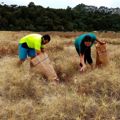Caring for Northland's dunes
Why protect our sand dunes?
Protect the dunes and they'll protect us
Beaches and sand dunes are the narrow but precious bands of sand that lie between the land and the sea.
Sand dunes are natural habitats for many native insects, lizards and birds. In their natural state, they protect land and property from erosion, storms, cyclones and tsunamis.
Large areas of Northland’s coastal dunes have been destroyed or highly modified to make room for production land and residential development. Only a very small proportion of our dunes remain. This has caused loss of habitat for native species and removed the protective function of the dunes.
Our remaining dunes are under pressure from increased beach use. Wheels, feet and animals destroy dune vegetation and create dune blow-outs, leading to loss of sand inland. They also damage archaeological sites and kill the threatened plant and animal species.
Climate change impacts, particularly sea-level rise, increase the importance of dunes as a natural defence against coastal hazards and place them under increased pressure. There’s still much we can do to protect and restore our remaining dunelands.
How do sand dunes work?
Sand dunes are constantly changing as they erode and build-up in cycles. Plants play an important part in the natural cycles of dune erosion and recovery that occur on beaches.
Settled weather...
Sand builds up on the beach and dunes.
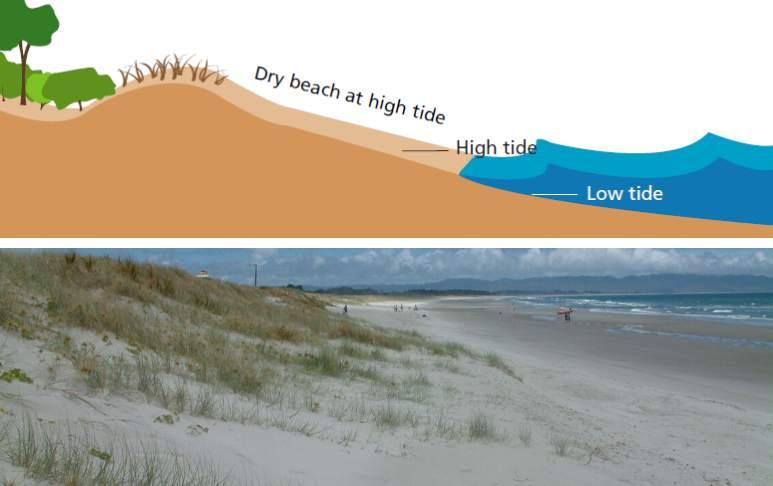
During a storm
Waves erode the beach and dunes, leaving a steep dune face. A bar is created as eroded sand settles offshore in the surf zone.
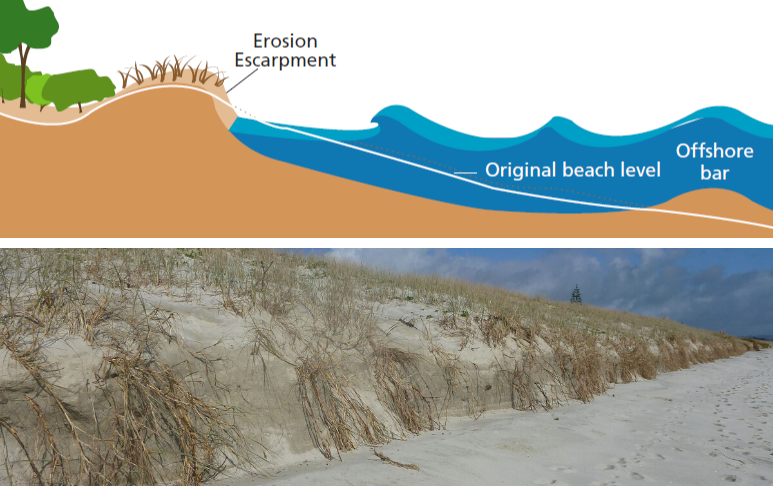
After a storm (short term, beach recovery)
Sand is transported back onshore and rebuilds the beach. Dune vegetation starts to grow seaward down the eroded dune face.
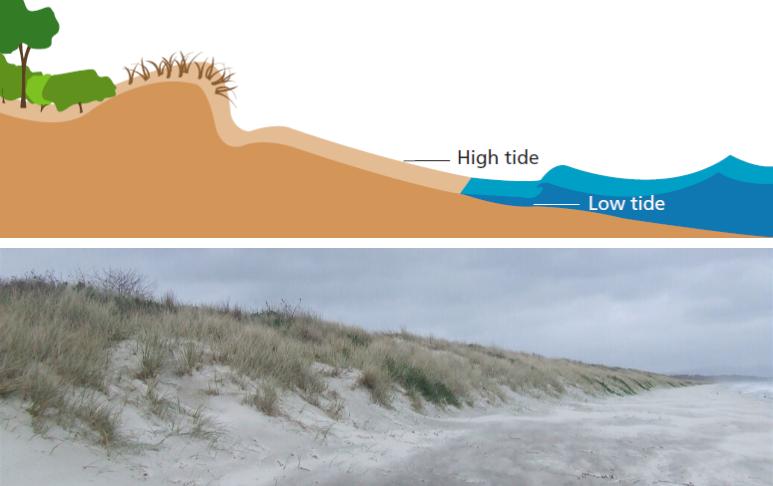
After a storm (long term, dune recovery)
Sand blown landward from the beach is trapped by dune vegetation, gradually repairing and rebuilding the dune.
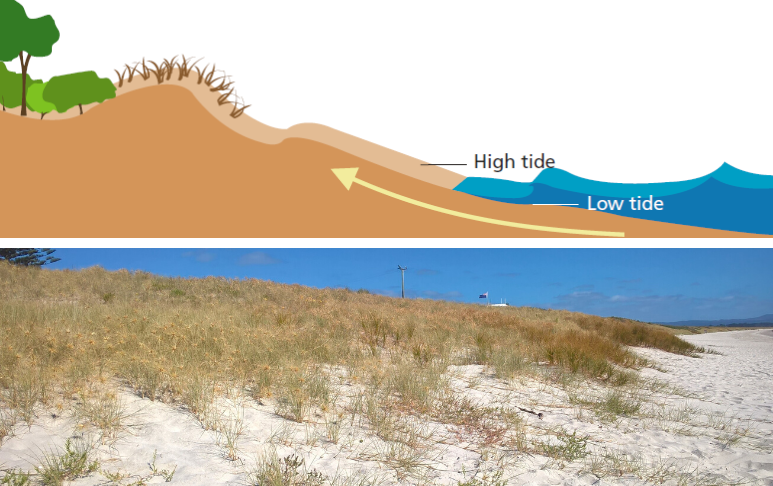
Native dune plants and zones
| Native plants play an important role in natural dune formation, as well as beach and dune values. |
| The dune system can be divided into three main zones – foredunes, mid dunes and back dunes. |
| In each zone in the dune environment, different native plant species are found. |
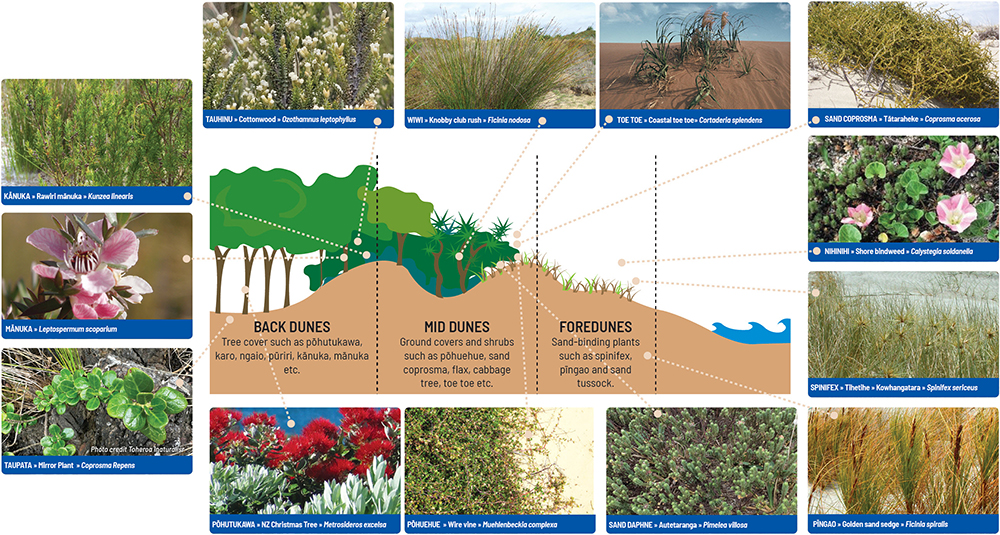
See the zone each of these native dune plants are best planted in.
Native dune plants
Can
- Reduce wind erosion and loss of sand inland.
- Build up sand dunes.
- Speed recovery of dunes after storms.
- Grow in the hostile and mobile coastal environment.
Can’t
- Prevent direct wave erosion.
- Withstand excessive damage from people, stock or vehicles.
- Cope with being mown.
- Tolerate introduction or encroachment of exotic plants.
Give the plants a chance
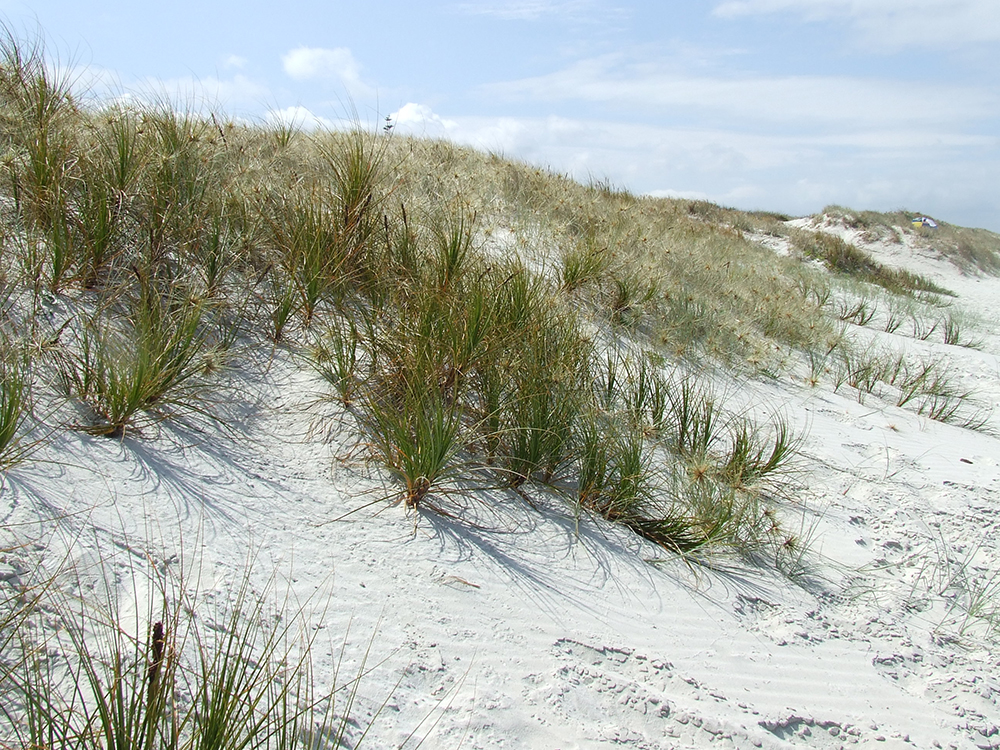
Pīngao (foreground) and spinifex are able to tolerate the harsh front dune environment and are important sand-binding plants.
Pest plants in our dunes
In many coastal areas, introduced species have been planted to try to stabilise or beautify dunes. Plants also spread onto dunes from neighbouring properties.
Unfortunately, these species take over from native dune plants, leading to loss of protective function and biodiversity values.
Problem species include: agapanthus, wattle (acacia), exotic iceplant and exotic grasses like kikuyu and buffalo grass.
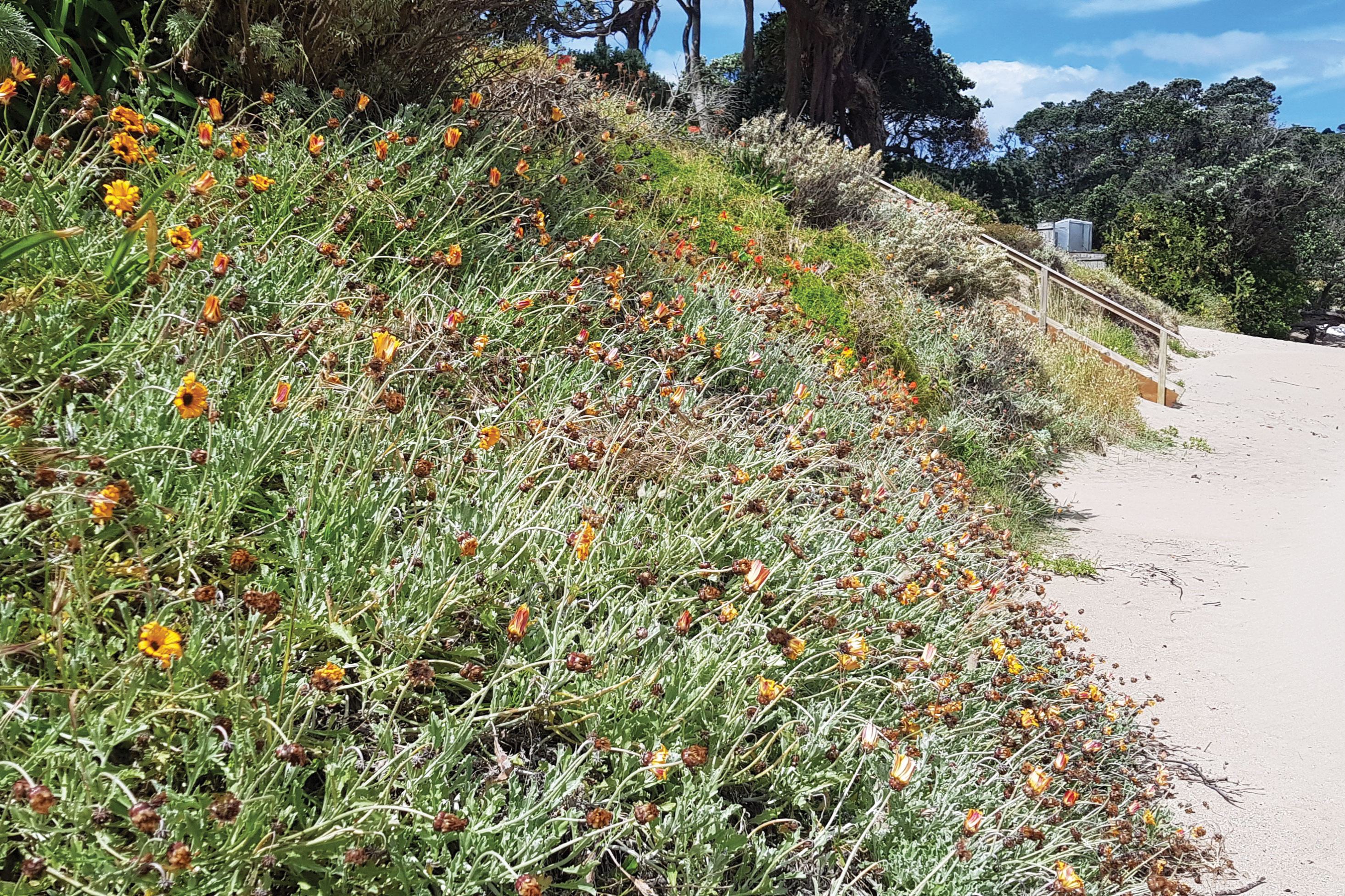
Exotic plants displace native plants.
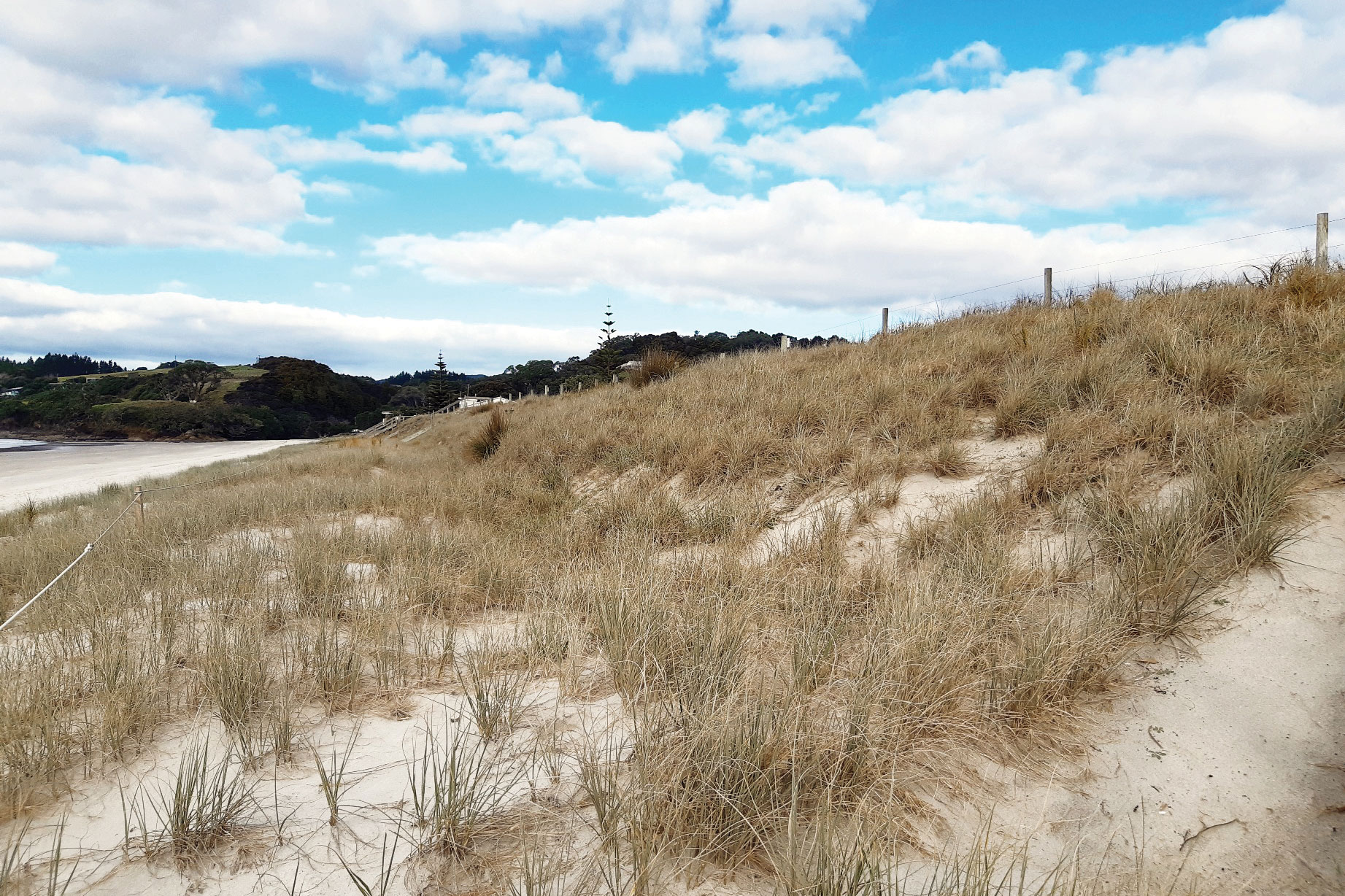
Native plants speed up recovery.
Help stop the spread of pest plants
Many pest plants are garden escapees – you can help by:
- Composting garden waste instead of dumping it onto the dunes.
- Keep lawn clippings and other plant cutting off the dunes.
- Removing invasive introduced plants and replacing them with natives.
- Keep native dune plants healthy by keeping to tracks.
Contact the Northland Regional Council for removal techniques and suitable replacement plants.
Dune restoration
Dune restoration looks different at different sites. At some sites the focus is on protecting the dunes from human damage. At nearly all sites weed and pest control is crucial.
At some sites replanting with native species is needed to restore natural function and biodiversity values. Where the dune has been modified it can be helpful to mechanically reshape the dune and remove exotic vegetation before planting.
Keep in mind that some areas are naturally unstable and are valued environments just as they are.
Before you commit to a project that’s trying to address dune stability, contact the Northland Regional Council for advice.
The Regional Plan has restrictions on earthworks and vegetation removal in the dune area – always check first.
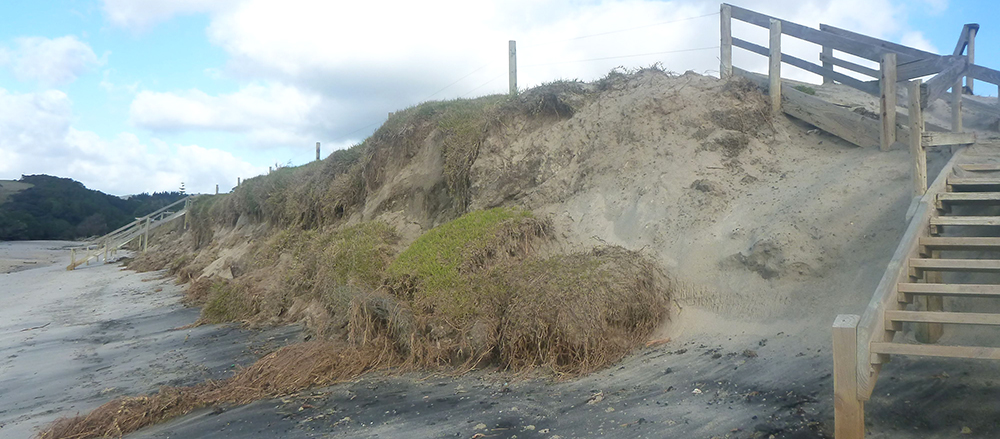
Waipu Cove after storm erosion.
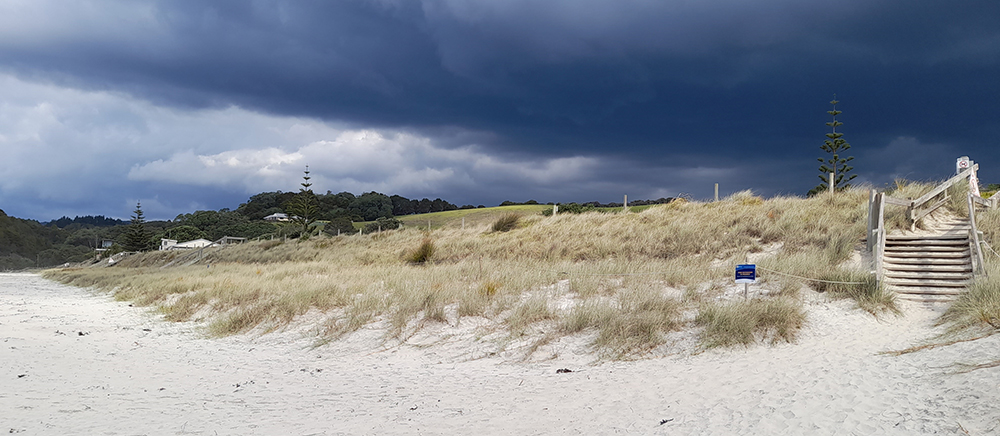
Waipu Cove after dune restoration work.
Ecosourcing for dune restoration
What can you do to help?
Stick to the tracks
Keeping off the dunes lets the plants do their job of building the dune.
Keep vehicles off the dunes
Wheels damage dunes and destroy dune plants and archaeological/cultural sites.
Trap those pests
Animal pests threaten our coastal plants and wildlife. Join the fight against these pests and get trapping at home or by joining a local group.
Bust those weeds
Exotic plants and weeds smother native vegetation. Keep garden weeds off the dunes! Join a local CoastCare group for weeding and planting natives on the dunes.
Watch out for wildlife
The beach is home to threatened native shorebirds who feed, nest and raise their young on open parts of the beach. Keep away from wildlife and fenced areas and keep dogs under control at all times, where they are allowed.
Be a tidy kiwi
Everything you bring to the beach needs to go home with you or into a nearby rubbish bin. If you see rubbish, do the right thing – pick it up. Every bit counts!
Take action – get involved
The Northland Regional Council CoastCare programme provides advice and support on dune restoration projects. This can also include provision of plants and other materials.
All around Northland’s coast hapu and local residents are involved in planting, weeding and protecting their dunes.
P: 0800 002 004 | E: info@nrc.govt.nz
Thanks to the Coastal Restoration Trust of New Zealand for allowing us to reproduce some of it’s information: coastalrestorationtrust.org.nz
NOTE: Coastal processes vary between beaches. The diagrams give a generalised example of how healthy dunes work. Actual erosion and recovery will vary between sites and is also dependant on climatic cycles.

